| Question | When to Plant Clover? |
|---|---|
| Answer | Spring after frost (early to mid-spring) or fall (late summer to early fall). |
| More Info |
|

Clover can be planted in both spring and fall, depending on your climate and goals for your lawn or garden.
- Spring Planting: Early to mid-spring, as soon as the soil can be worked, is a good time to plant clover, especially in cooler climates. Planting in spring allows the clover to establish itself before the summer. Make sure the threat of frost has passed to ensure the seeds can germinate properly.
- Fall Planting: Late summer to early fall is ideal for planting clover in most regions. This timing allows the clover to establish before winter. In warmer climates, fall planting helps avoid the heat stress of summer and takes advantage of fall rains for natural watering.
Clover prefers well-drained soil and a location with full sun to partial shade. It’s known for its nitrogen-fixing ability, making it beneficial for soil health.
Ideal Clover Planting Times
Choosing the optimal time to plant clover is essential for a successful establishment.
Gardeners should consider the regional climate and the specific temperature needs of clover.
In regions with cold winters, it’s best to plant clover in the spring.
The timing hinges on soil warmth, with ideal conditions when temperatures consistently remain above 60°F.
For those with mild winters, the ideal planting time shifts to late summer or early fall.
Here, the aim is to ensure the seeds benefit from cooler temperatures and natural rainfall, enhancing germination.
Ideal Conditions by Region
- Cold Winter Areas: Spring, post-last frost, with nighttime temperatures above 40°F
- Mild Winter Areas: Late summer to early fall, after a soaking rain to increase germination
Clover requires adequate water during its initial growth phase, so gardeners should aim to plant when there’s sufficient rainfall, or provide irrigation.
Soil Preparation
Before planting, the soil should be loose to a depth of 6-8 inches.
Testing the soil pH is also advisable, as clover prefers a slightly acidic environment (pH 6.0-6.5).
| Month | Cold Regions | Mild Regions |
|---|---|---|
| March-April | Best time to plant, after last frost | |
| May-August | Monitor soil temperature and moisture | Ideal for growth and establishment |
| September-October | Plant at least six weeks before expected frost |
Preparing the Soil for Clover
When planting clover, soil preparation is crucial for successful germination and growth.
Gardeners should begin by testing the soil’s pH. Clover prefers a pH level between 6.0 and 7.0.
If the pH is too high, incorporating materials like peat moss or sulfur can lower it. Conversely, a pH below 6.0 requires the addition of lime to raise it.
The soil texture is also important for clover.
They thrive in well-draining soil with a good mix of sand or fine sawdust. This ensures adequate water flow and root development.
Before seeding, one should remove any debris, like leaves or clippings, to expose the soil surface.
It’s then advisable to loosen the soil using a rake or tiller. This will provide a suitable seedbed for the clover.
Adequate preparation entails:
- Testing Soil pH: Adjust pH if necessary.
- Amending Soil Texture: Mix in sand or sawdust if required.
- Clearing Debris: Rake away leaves and clippings.
- Loosening Soil: Use a rake or tiller to create a fine seedbed.
Choosing the Right Clover Variety
Selecting an appropriate clover variety is critical for a successful planting.
The gardener must consider the clover type and the climate adaptability of each variety.
Considerations for Clover Type
When gardeners are choosing a clover variety, they should assess the intended use of the clover in their landscaping or agricultural efforts.
Clovers, with their nitrogen-fixing abilities, enhance soil quality and are often used as cover crops.
The most common types found in gardens and lawns are Red Clover and White Clover:
- Red Clover (Trifolium pratense): Taller and bushier, this variety is well-suited for use as a forage plant or a green manure.
- White Clover (Trifolium repens): A low-growing, fast-spreading variety that serves excellently as a lawn alternative or ground cover.
The gardener should also consider bloom time, maintenance requirements, and the clover’s purpose, be it for aesthetic appeal, soil improvement, or wildlife forage.
Climate Adaptability of Clover Varieties
Clovers are generally robust and can adapt to a range of climates.
Each variety, though, may have a specific range where it thrives best. For instance:
- Hardiness Zones: Some clover varieties are capable of growing in USDA Hardiness Zones 3 through 10, making them quite versatile.
- Temperature Tolerance: The ideal temperature range for White Clover growth is between 10 to 30°C (50 to 85 °F), requiring good drainage.
To ensure a good fit between a clover variety and the local climate, the gardener should select a type recommended for their specific climate zone.
Cold-tolerant varieties are better suited for fall planting and can survive through frosts, while others may prefer the warm spring temperatures for germination and growth.
Planting Techniques for Clover
The successful establishment of a clover lawn or garden area hinges on the method used to plant the seeds and the preparation of the soil for optimal seed-to-soil contact.
Seeding Methods
Broadcasting: This is the most common seeding method for clover, involving the even scattering of seeds directly onto the soil surface.
This can be done by hand or with a mechanical spreader. After broadcasting, it’s often recommended to lightly rake the area to ensure seeds are distributed evenly.
Overseeding: For enhancing existing lawns, overseeding with clover involves spreading clover seeds over the current turf.
This adds biodiversity to the lawn and requires less preparatory work compared to starting a new lawn from scratch.
Soil Coverage and Seeding Depth
Soil Contact: Clover seeds need to be in direct contact with the soil to germinate effectively.
Before seeding, one should mow existing grass to a height of around 2 inches and remove thatch to allow seeds to reach the soil.
Seeding Depth: The ideal seeding depth for clover is about 1/4 inch.
Seeds should not be buried too deeply; a light covering is all that’s needed.
After distributing the seeds, a gentle compression (using a roller or walking across the area) can help improve seed-to-soil contact without burying the seeds too deep.
- Optimal soil coverage for clover seeds:
- Mow existing grass: 2 inches short
- Remove thatch: Clear to expose soil
- Seed depth: 1/4 inch
- Compression: Gentle, to improve contact
Post-Planting Care and Maintenance
Once clover seeds are planted, adequate watering and soil management are vital to establish a healthy and vibrant clover lawn.
Watering Requirements
Clover requires consistent moisture, especially during the germination phase.
Following planting, it’s essential to:
- Keep the soil moist, but not oversaturated, to encourage seed germination.
- Water the planted area with a gentle spray to prevent seed displacement.
- Maintain a watering schedule that provides 1 inch of water per week, whether from rainfall or irrigation.
Fertilization and Soil Management
Clover benefits from soil that’s:
- High in phosphorus and potassium but low in nitrogen, as clover fixes its own nitrogen.
- Of a pH level between 6.0 and 7.0; soil testing can determine if amendments are needed.
For optimal soil management:
- Apply a phosphorus and potassium-rich fertilizer according to soil test results.
- Avoid nitrogen-rich fertilizers to prevent competing grasses from overpowering the clover.
Frequently Asked Questions
Before embarking on your clover planting journey, it is crucial to understand the specifics regarding temperature requirements, effective sowing methods, establishment timelines, and optimal planting schedules. Here are the details:
What is the ideal temperature for clover germination?
Clover germination is most successful when soil temperatures are between 35 and 45 degrees Fahrenheit at night.
These temperatures typically occur in spring, making it an ideal season for planting clover.
How can clover be planted effectively in an existing lawn?
To plant clover in an existing lawn, start by loosening the top layer of soil.
Then, spread the clover seeds evenly across the soil surface, and lightly rake them in. Water the area consistently until germination occurs.
How long does it typically take for clover to become fully established?
Clover typically takes several weeks to germinate and can take a full growing season to become fully established.
Regular mowing and maintenance can extend its lifespan up to three years.
What are the recommended planting dates for white clover?
White clover should be planted when soil temperatures are optimal, usually between February and May.
This allows the clover ample time to establish before the extremes of summer or winter.
Is there a difference in planting times for clover intended for deer habitat?
Clover intended for deer habitat can be planted during spring, summer, or fall.
However, for the best results, aim for spring planting to take advantage of rainfall and moderate temperatures, thus providing a lush food plot for wildlife.
Does clover growth rate vary, and what factors influence it?
The growth rate of clover can vary based on several factors. These include soil fertility, moisture levels, and local climate conditions.
Well-drained soil with a slightly acidic pH and consistent watering will promote faster and more vigorous growth.
Last update on 2025-04-29 / Affiliate links / Images from Amazon Product Advertising API





